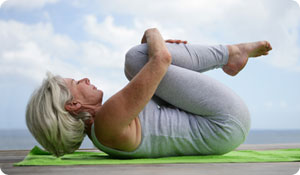
If you're living Parkinson's Disease, you may wonder whether exercising is a wise idea. The answer, say many experts, is yes. Physical activity may slow the progression of the disease and confers other health benefits as well.
"Exercise can give you greater strength and independence," says Steven H. Schechter, MD, co-author of Understanding Parkinson's Disease. "It may also improve balance, help you overcome gait problems, strengthen particular muscles, and improve your speech and swallowing."
Both stretching exercises and aerobic exercises can be helpful, and if you get enough of a workout to break into a light sweat, you may feel more positive and less depressed, Schechter says. That's because exercise releases endorphins, which are the body's own "feel-good" chemicals. Also, he points out, exercising regularly helps you feel more connected and in control.
According to the National Parkinson Foundation, stretching, aerobic exercise, and resistance (weight training) are key components to a successful exercise program. Besides biking and running, Tai Chi, yoga, Pilates, and dancing can all have a positive impact on individuals with Parkinson's. Here's how to exercise successfully.
- Start out slowly, recommends Schechter. If you try to do too much too soon,
you'll only wind up with sore muscles and maybe even an injury. - Be sure to exercise when you're rested, when your medicine is working, and when you're wearing loose, comfortable clothing. And if an exercise feels painful, stop doing it immediately.
- "Practice walking sideways, backwards, and in circles several times a day," says Schechter. "Take large steps, lifting your toes when you begin a step and letting your heels hit the floor first as you step forward." Raising your toes from the walking surface with every step helps prevent stumbling. You can use toe-lifting to "unglue" your feet and legs from an episode of freezing, Schechter says, and to relieve muscle spasms. As you walk, straighten up and try to look straight ahead, and swing your arms as you walk. In addition to walking, recreational exercises such as golfing and bowling not only keep your muscles and joints flexible, but can provide you with social opportunities, Schechter explains.
- Try swimming. It's a wonderful form of exercise for individuals with Parkinson's, Kohles says. "Getting into the pool can help someone with Parkinson's feel fabulous," she says. "He doesn't have to worry about falling, and she's lifted up by the water. She'll feel like herself again."
If you aren't sure how much exercise to try to get, consider this: "The more exercise, the better," says Caroline Kohles, senior director of fitness and wellness at the JCC of Manhattan, which partners with the NYU Langone Movement Disorder Center in New York City to offer exercise classes for those with Parkinson's Disease. "Exercise can really help with mobility, and it brings more oxygen to the brain," she explains.
Source:
"Exercise." Parkinson's Disease. National Parkinson Foundation. href="http://www.parkinson.org/Parkinson-s-Disease/Treatment/Exercise">
http://www.parkinson.org/Parkinson-s-Disease/Treatment/Exercise





